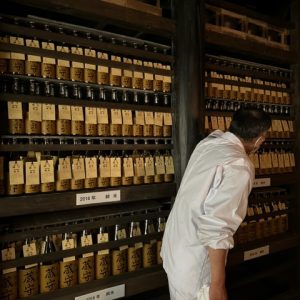Sake walking in Japan
Today, I did a short walk along the Tama River from Mitake to Sawai (the Mitake Gorge trail). As you can see from the photos, this portion of the Tama is still very natural and beautiful. As you can also see, there are lots of middle-age ladies walking in the area — photo taken from the train.
In fact, the Tama River is rather long, extending 138 kilometres west of Tokyo. Its source is located at Mt. Kasatori in Koshu in Yamanashi Prefecture, and it flows through Tokyo, on the dividing line between Tokyo and Kanagawa.
Near the beginning of the walk is an art museum, showcasing the works of Gyokudo KAWAI, a great master of Japanese painting. In fact, the artist spent the last years of his life living in the beautiful building, which is set on the edge of the river and nestled in the forest.
The walk along the river bank is very nice, with many flowering lilies. Going along, there is the occasional building, often serving coffee or simple fare.
The planned highlight of the walk was a visit to the Ozawa sake brewery. My first question to the guide was why do you make sake in this mountainous region, cut through by the Tama river. There is not a rice paddy in sight, and the topography does not seem to suit rice cultivation.
The answer is the very high-quality water — not from the Tama River, but underground water from the hills behind the Ozawa sake brewery. The water is rich in minerals, while containing very little iron, manganese or organic matter, making it perfect for brewing sake.
Indeed, while sake is composed of only four natural ingredients — rice, water, yeast, and koji — there is one ingredient that stands out above them all, and that is water. In its final stage, sake is approximately 80% water.
While before urbanisation, rice was grown not so far away, now it is shipped in from a distance. In fact, there are a number of rice breeds that can be used for brewing sake, but they are quite different from those we eat.
Yamada Nishiki is sometimes called the “King” of sake rice. Grown in Hyogo, as well as Fukuoka, Tokushima and Okayama, this rice is often used to make the more delicate styles of premium sake, especially daiginjo. Other rice species suitable for making sake include Gohyakumangoku (Niigata), Miyamanishiki (Nagano), and Omachi (Okayama).
As is so often the case with Japanese enterprises, the Ozawa sake brewery is very old, having been founded in 1702. It is also the oldest sake brewery in the region of Tokyo. The brewery makes a range of sake products and even ages some to allow a more mature flavour to develop.
Across the Tama River from the Ozawa sake brewery is the Kanzanji temple, hidden up in the trees. It is named after the temple in Suzhou, China, and was built in 1930. A slow gallop up the hill was a great antidote to a delicious lunch, washed down with some sake.





